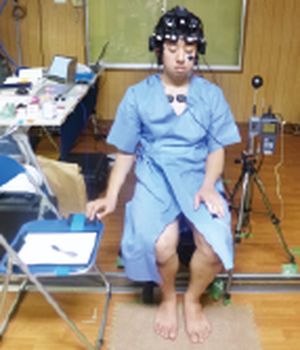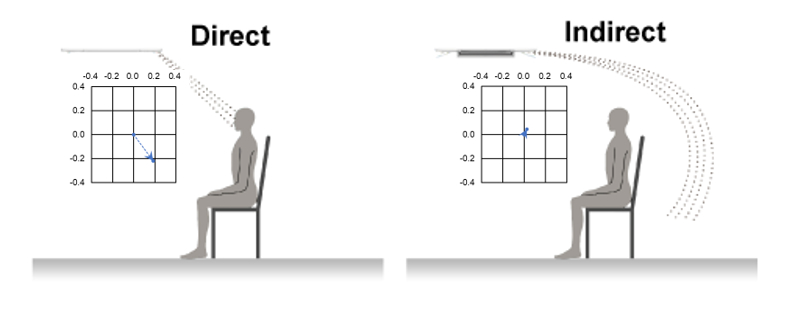研究成果 Research Results
- TOP
- News
- Research Results
- Effect of cool airflow on comfort more than just a feeling
Effect of cool airflow on comfort more than just a feeling
Study uses both subjective and physiological measurements to show the influence of cooling airflow direction on comfort 2021.04.26Research ResultsLife & Health
Could improving comfort and productivity be as simple as changing the direction of your air conditioner vents during the summer? Using a series of physiological measurements, a new study from researchers at Kyushu University provides new experimental evidence that this just might be the case.

Assoc. Prof. Tsuyoshi Okamoto
“The flow of air in a room is known to influence comfort, but evaluations have so far been primarily based on assessments of feelings that are subjective, which can lead to discrepancies,” explains Tsuyoshi Okamoto, associate professor at Kyushu University’s Faculty of Arts and Science and leader of the new study in PLOS ONE.
“In our study, we combined subjective assessments with physiological measurements of things such as heart rate and brain activity to obtain a more reliable understanding of this relationship.”
Using facilities at Mitsubishi Heavy Industries, Ltd., Okamoto and his team investigated the responses of 19 participants who entered a controlled environment at 20 °C after spending 20 minutes in a 32 °C room to simulate coming in from outdoors during summer in Japan.

A participant performs mental tasks while being measured under different airflows.
In the cooled environment, study participants performed a set of simple mental tasks under either direct or indirect airflow for 20 minutes followed by another round of tasks under the opposite airflow conditions.
The researchers were able to control the airflow by using an air conditioner manufactured by Mitsubishi Heavy Industries Thermal Systems, Ltd., equipped with Draft Prevention Panels* to blow across the participants’ faces in the case of direct airflow or to travel along the ceiling before descending to achieve indirect airflow.
During this time, the researchers took measurements including skin temperature and electrical signals from the brain and heart while also periodically asking the participants for subjective assessments of their comfort.
In addition to reporting higher satisfaction with the temperature of the room and overall pleasantness, the participants under indirect airflow also counted seconds more slowly in their heads, indicating the suppression of negative emotions.

Under direct and indirect airflow, the air speed—shown in the insets in meters per second—variedly greatly at face level.
The physiological measurements provided additional evidence for confirming these feelings under indirect airflow, such as the reduction of the strength of brain waves in frequencies known as beta and gamma bands and differences in heart measurements that indicate a higher level of alertness when working on the mental tasks.
Furthermore, face temperature significantly declined when the air was directed at the participants face unlike under indirect airflow.
“This study provides reliable evidence that indirect airflow is indeed more comfortable, and these procedures could be extended for other evaluations of feelings,” says Okamoto.
“Another benefit of indirect airflow is that it can reduce the number of particles that are stirred up into the air and subsequently breathed in, making the benefits double fold,” he adds.
###
For more information about this research, see “Physiological and subjective comfort evaluation under different airflow directions in a cooling environment,” Kaori Tamura, Sayaka Matsumoto, Yu Hsuan Tseng, Takayuki Kobayashi, Jun’ichi Miwa, Ken’ichi Miyazawa, Toyotaka Hirao, Soichiro Matsumoto, Seiji Hiramatsu, Hiroyuki Otake, and Tsuyoshi Okamoto, PLOS ONE (2021). https://doi.org/10.1371/journal.pone.0249235
This release is also available in Japanese.
*For the ceiling-embedded type four-way blowout indoor unit (FDT), panels with a windshield mechanism (Draft Prevention Panel) were adopted for the first time in the industry. Conventionally, when a user does not want to be directly exposed to the wind of an air conditioner, a wind direction adjusting plate has been installed near the outlet as a local option. However, by integrating the Draft Prevention Panel, the user can open and close the panels simply using the remote control.
Research-related inquiries
Tsuyoshi Okamoto, Associate Professor
Faculty of Arts and Science
Contact information can also be found in the full release.
- TOP
- News
- Research Results
- Effect of cool airflow on comfort more than just a feeling































